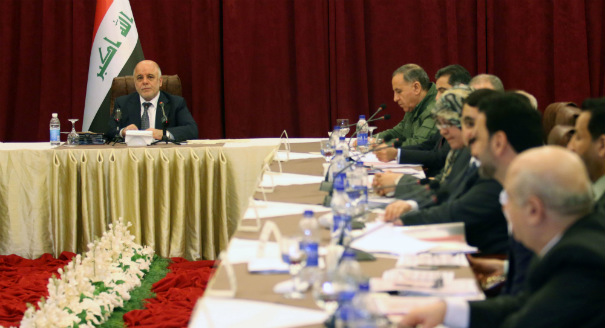The liberation of Ramadi’s city center on December 28 came two years to the day after former Prime Minister Nouri al-Maliki began his ill-conceived military shutdown of the symbolic protester camp north of the city, galvanizing a Sunni insurgency that quickly engulfed the entire Anbar province. For nearly a year and a half after that, government-aligned forces—including army units, federal and local police, and irregular fighters from local tribes—fought a back-and-forth, neighborhood-by-neighborhood battle with militants from the Islamic State (IS). After the victory, Prime Minister Haider al-Abadi’s flag-planting in the city center on December 29 allowed him to end 2015 on a high note, but challenges remain.
Despite the victory, Iraq’s security forces appear to still require substantial rebuilding. As reported by the Wall Street Journal, while regular army units, federal and local police, and allied tribal fighters played supporting roles, the elite Counter Terrorism Service (CTS), known colloquially as the “Golden Brigade,” did the bulk of the fighting. They were heavily supported by U.S. airstrikes that destroyed the liberated areas. Moreover, the liberation did not include substantial portions around the city center, and it appears that continued progress will depend on the CTS. Despite efforts to build Anbar’s “tribal Hashd”—Sunni tribesmen fighting on Baghdad’s side, a key element of the Pentagon’s Iraq Train and Equip Fund military assistance program—these forces are nominally only about 5,000 fighters and appear to be at best a support force that can hopefully hold liberated areas after others have done the heavy fighting.
Two other key fights awaiting these forces in Anbar are Fallujah, east of Ramadi near Baghdad, and Haditha, north of Ramadi. While Fallujah fell to IS without resistance in January 2014, Haditha has resisted an estimated 200 attacks by the militants against local tribesmen defending the city. According to an Al-Jazeera interview with Iraqi analyst Liqa Makki, tribal dynamics have empowered Haditha’s defense but also impede conclusive action—the two key tribes in the area, the Jughaifa and the Albu Nimr, fight in part to avenge tribesmen killed by IS, yet the Jughaifa’s long dominance of local administration is itself a source of conflict that keeps the tribes divided.
Meanwhile, the Islamic State is putting security forces on the defense by returning to its pre-2014 approach of hitting soft civilian targets instead of taking and holding territory, which they no longer have the manpower to do. A series of terrorist attacks took place on January 11 in Baghdad, Muqdadiya, and Diyala—a demographically mixed area from which Shia militias expelled IS over a year ago. And on January 12 there were several attacks on Sunni mosques in Diyala, as well as the cold-blooded execution of two journalists from the Sunni television channel Al-Sharqiya—an attack apparently staged to send a message to Diyala Sunnis that Abadi cannot protect them.
These attacks triggered outrage among Abadi’s few Sunni allies. Speaker of Parliament and Diyala native Salim al-Jabouri condemned the attacks, saying that they called into question the legitimacy of the state and insinuating that the Hashd was implicated. Former Vice President Osama al-Nujaifi also made headlines by calling for the “internationalization” of Diyala security through UN intervention, and the Sunni Union of Nationalist Forces boycotted two parliament sessions. But these statements were only meant to put pressure on Abadi, as there is no chance that the UN would even be able to enter Diyala much less conduct peacekeeping operations there.
In addition to the ongoing challenges in Anbar and Diyala, Abadi faces a different host of challenges in Basra. While struggling to respond to the Diyala attacks, he had to focus on Basra during a preplanned cabinet trip there on January 12 and 13. In Iraq’s economic capital, Abadi sought to assert himself at the center of the Shia political scene and address the growing violence that is raising fears Basra is moving toward intra-Shia violence as the Sunni terror threat recedes. Over the past year, the Islamic Supreme Council of Iraq (ISCI), to which Governor Majid al-Nasrawi belongs, and the Badr Organization, which controls both the local Hashd organization and—through its control of the federal Ministry of Interior—has one of its own as police chief, have struggled over control of local security. In a speech to tribal leaders in Basra, Abadi expressly linked violence in the province to “differences of opinion,” not simply criminal violence or the intensification of traditional tribal feuds. Moreover, in his cabinet meeting comments on January 12, just after arriving in Basra, Abadi expressly tied the province’s violence to “conflicts between political blocs.”
Abadi was also forced to address the ongoing non-sectarian anti-corruption protests in Basra that hit their peak in August 2015. In a speech on January 13 to a group of local students and professionals, Abadi sought to reframe the issue as a fight against figures who used dirty money to establish anti-government television channels and exploit the armed insurgency to achieve their political goals. This was an attempt to shield both the Shia parties and pro-government Sunnis while focusing anti-corruption efforts on oppositionists. Yet Abadi’s effort to redefine “reform” may further disillusion the anti-corruption protest movement—which after initially giving him a boost has already begun turning against him.





